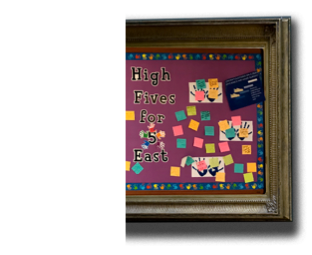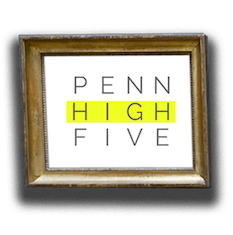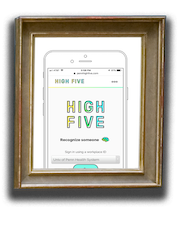
Prototype
Medical errors can result in harsh consequences while successes are rarely recognized to the same extent. These asymmetrical rewards are thought to be a key contributor to physician burnout. Courteous interpersonal behaviors that capture compelling expressions of appreciation, and affirmations of meaningful contribution emphasizing why and how people matter, have the potential to balance this asymmetry. While traditional means such as nomination-based systems can enable such expressions, many are top-down in construct and lack automation, increasing the friction associated with sharing and leveraging the positive energy expressed in a timely fashion.
Since 2016, our multidisciplinary team has been exploring the feasibility of a web-based multimedia communication platform designed to enable digitally mediated expressions of appreciation and recognition among colleagues and, by extension, encourage a civility climate within a health care setting. We drew inspiration from the peer-peer recognition boards on hospital floors proudly displaying “paper high fives,” aka the original low-cost prototype for the High Five platform.

Mockup
Early on, with limited funding and design experience, we launched a low-cost web-based minimal viable product (MVP). We drafted initial mockups in Google Slides with High Five’s trusty ‘Raleway’ font before moving to a bare-bones website that offered our peers the ability to easily find and recognize each other using uplifting memes, gifs, and messages.

Implement
Since 2016, our team has explored the feasibility of a web-based multimedia communication platform designed to enable digitally mediated expressions of appreciation and recognition among colleagues and, by extension, encourage a civility climate within a health care setting. In 2017, we added introduced live feeds of High Fives that could be displayed to on web-enabled displays mounted in clinician and staff workspaces. In the Emergency Department we found a 65% sustained increase in usage following this upgrade. Three years later, over 11k Penn Medicine employees have exchanged over 38k high fives! Today, our platform averages over 1,500 users a month across the health system. To celebrate our 3-year anniversary and our amazing Penn Medicine community, we enlisted the help of some seriously talented folks to help us upgrade our site. High Fiving on our platform has never been easier, and hopefully it’s even more fun than before. Take it for a spin and let us know what you think!

Minimize friction
We knew from the beginning we wanted to make the platform as easy to access as possible! As such, we’ve built a mobile-enhanced website (instead of an app) that can be utilized across different devices and operating systems without a download. Users can easily find other employees by name (even partial names), position, and/or department via the platform’s intuitive search function. To send a High Five, users select from a library of curated images curated and insert a positive sentiment. Users have the option to personalize the communication with a free text message and to then share the message with the recipient’s supervisor. Images include a variety of memes – altered spreadable media in the form of static or animated images that leverage humor, pop culture, and social media trends.

Up next
As we grow our High Five community, we’re excited to further explore the concept of workplace civility as a driver for culture in the health care setting. We are committed to lifelong iterative improvement. To learn more about the insights, we’ve gathered to date by checking out our publication in NEJM Catalyst: Innovations in Care Delivery
The iterative evolution of the aseptic hospital high five
High Five is powered by the Center for Health Care Innovation and Center for Digital Health at Penn Medicine. Learn more about the iterative and agile approach we use to apply design-thinking in the health care space. We believe the best way to make significant improvements is to experiment quickly at low cost - scaling only once we find high impact solutions.
About
The iterative evolution of the aseptic hospital high five
High Five is powered by the Center for Health Care Innovation and Center for Digital Health at Penn Medicine. Learn more about the iterative and agile approach we use to apply design-thinking in the health care space. We believe the best way to make significant improvements is to experiment quickly at low cost - scaling only once we find high impact solutions.

Prototype
Medical errors can result in harsh consequences while successes are rarely recognized to the same extent. These asymmetrical rewards are thought to be a key contributor to physician burnout. Courteous interpersonal behaviors that capture compelling expressions of appreciation, and affirmations of meaningful contribution emphasizing why and how people matter, have the potential to balance this asymmetry. While traditional means such as nomination-based systems can enable such expressions, many are top-down in construct and lack automation, increasing the friction associated with sharing and leveraging the positive energy expressed in a timely fashion.
Since 2016, our multidisciplinary team has been exploring the feasibility of a web-based multimedia communication platform designed to enable digitally mediated expressions of appreciation and recognition among colleagues and, by extension, encourage a civility climate within a health care setting. We drew inspiration from the peer-peer recognition boards on hospital floors proudly displaying “paper high fives,” aka the original low-cost prototype for the High Five platform.

Mockup
Early on, with limited funding and design experience, we launched a low-cost web-based minimal viable product (MVP). We drafted initial mockups in Google Slides with High Five’s trusty ‘Raleway’ font before moving to a bare-bones website that offered our peers the ability to easily find and recognize each other using uplifting memes, gifs, and messages.

Implement
Since 2016, our team has explored the feasibility of a web-based multimedia communication platform designed to enable digitally mediated expressions of appreciation and recognition among colleagues and, by extension, encourage a civility climate within a health care setting. In 2017, we added introduced live feeds of High Fives that could be displayed to on web-enabled displays mounted in clinician and staff workspaces. In the Emergency Department we found a 65% sustained increase in usage following this upgrade. Three years later, over 11k Penn Medicine employees have exchanged over 38k high fives! Today, our platform averages over 1,500 users a month across the health system. To celebrate our 3-year anniversary and our amazing Penn Medicine community, we enlisted the help of some seriously talented folks to help us upgrade our site. High Fiving on our platform has never been easier, and hopefully it’s even more fun than before. Take it for a spin and let us know what you think!

Minimize friction
We knew from the beginning we wanted to make the platform as easy to access as possible! As such, we’ve built a mobile-enhanced website (instead of an app) that can be utilized across different devices and operating systems without a download. Users can easily find other employees by name (even partial names), position, and/or department via the platform’s intuitive search function. To send a High Five, users select from a library of curated images curated and insert a positive sentiment. Users have the option to personalize the communication with a free text message and to then share the message with the recipient’s supervisor. Images include a variety of memes – altered spreadable media in the form of static or animated images that leverage humor, pop culture, and social media trends.

Up next
As we grow our High Five community, we’re excited to further explore the concept of workplace civility as a driver for culture in the health care setting. We are committed to lifelong iterative improvement. To learn more about the insights, we’ve gathered to date by checking out our publication in NEJM Catalyst: Innovations in Care Delivery